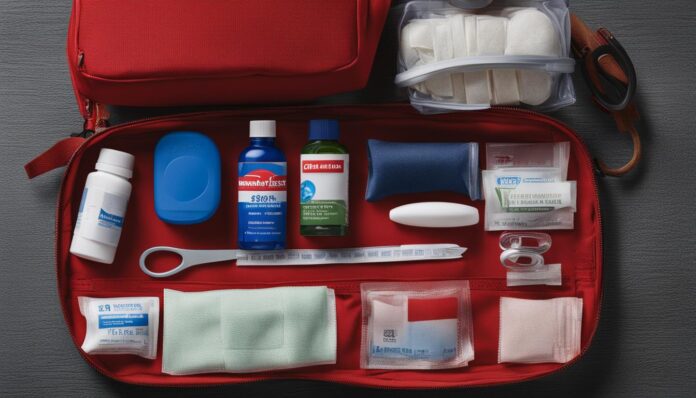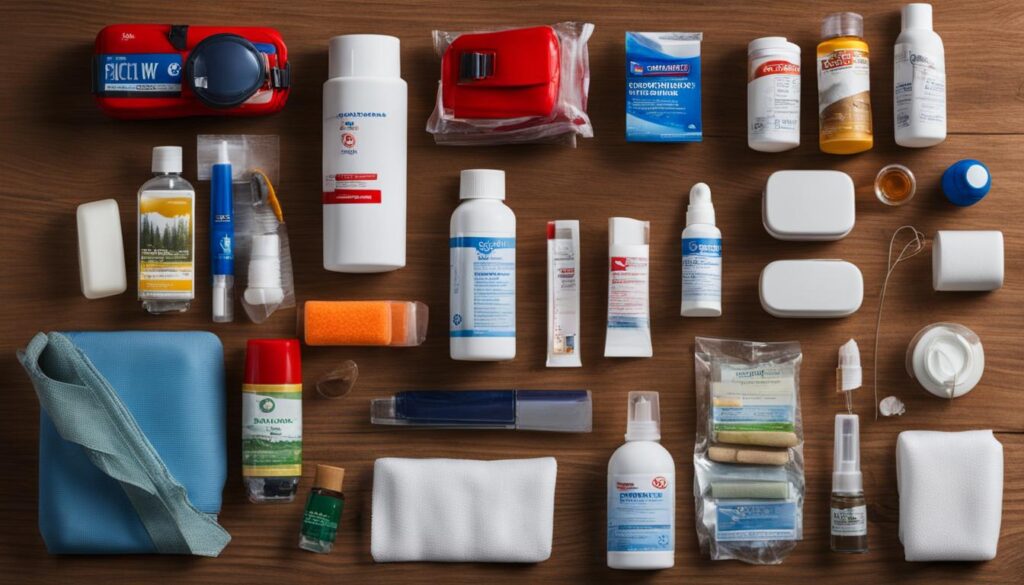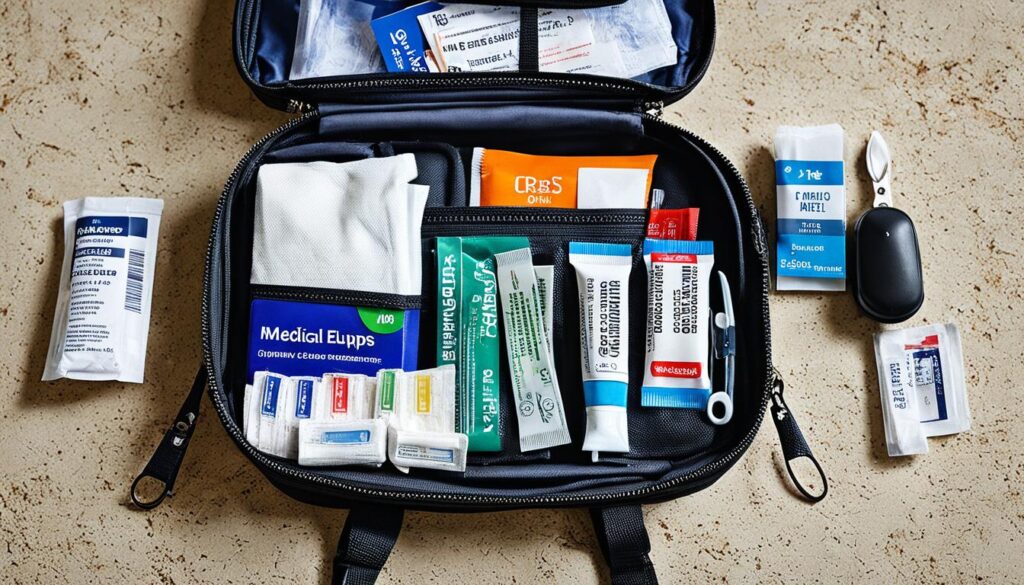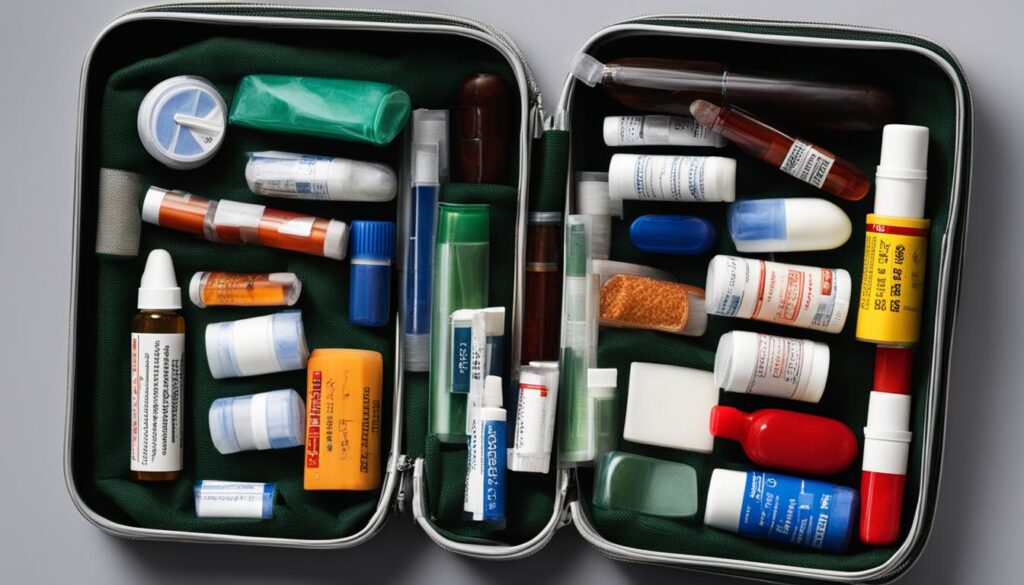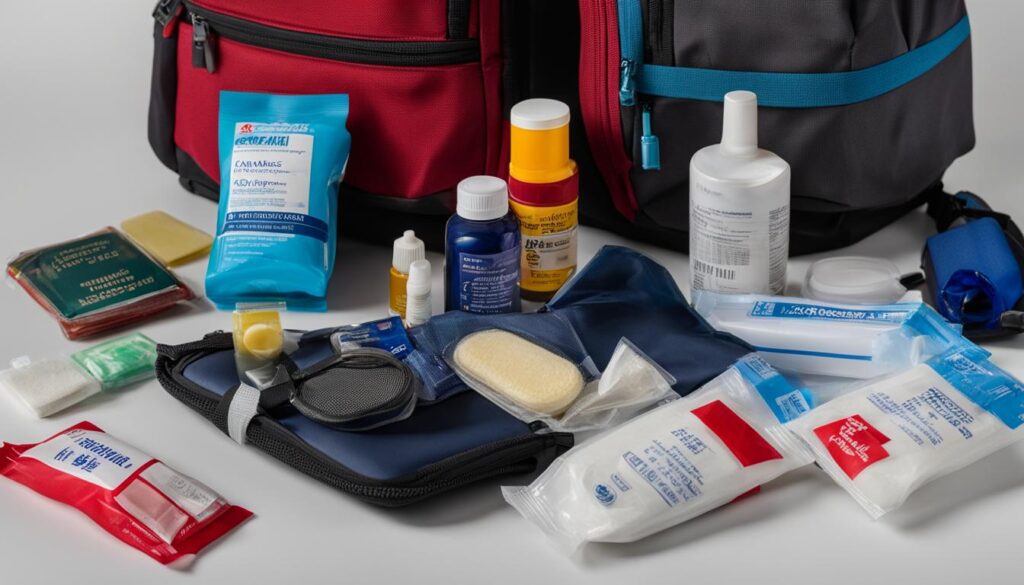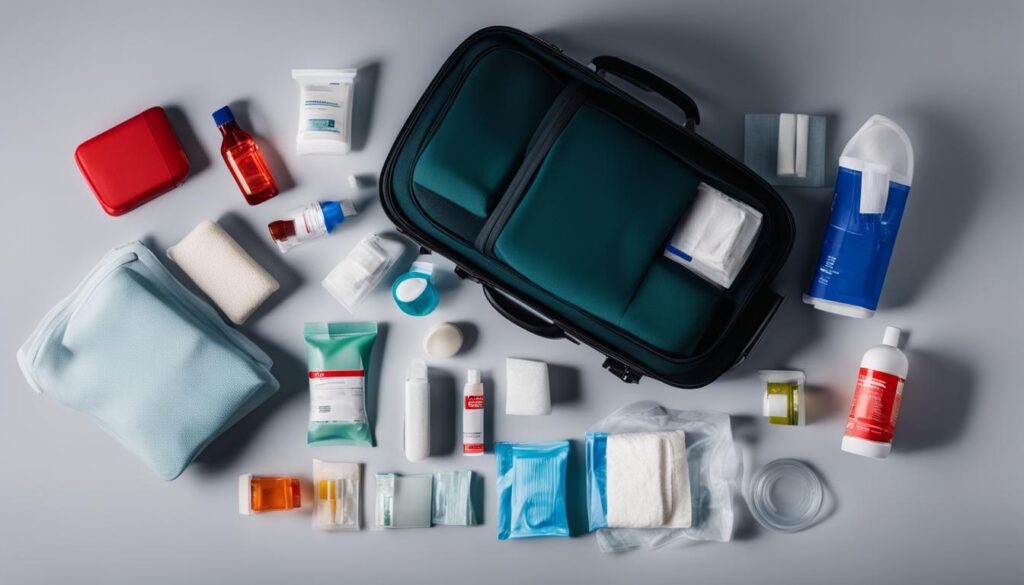Traveling is a thrilling experience, but the unexpected can happen, and that’s why it’s essential to pack a travel first-aid kit. Being prepared saves time, money, and, more crucially, one’s life. In this comprehensive guide, we will provide you with tips and tricks on Building a travel first-aid kit as well as the necessary supplies required for your safety, starting from assessing your travel needs to packing and carrying your kit. So, let’s get started!
Whether it is a business trip, vacation, or adventure travel, your safety should be a top priority. A well-packed travel first-aid kit will provide security for you and your family’s health, medical needs, and potential emergencies. This guide will equip you with the necessary knowledge required to build a medical kit, considering the duration and location of your trip. We will provide insight on the required medications and prescription drugs to add to your kit. Moreover, we’ll cover special considerations for adventure travel, traveling with children, and the importance of travel insurance.
Don’t let a health emergency ruin your trip. Let’s build that essential travel first-aid kit together, starting with assessing your travel needs.
Assessing Your Travel Needs
Before assembling your travel first-aid kit, you must assess your individual needs. Depending on the duration and location of your trip, you may require specific medical supplies and first-aid tools. Consider any pre-existing medical conditions or allergies you may have, as well as any prescription medications you take regularly.
If you plan to engage in various activities such as hiking, swimming, or camping during your trip, you will require additional supplies. For example, if you’re traveling to a location where you may come across mosquitoes or ticks, you will need insect repellents and tick removers in your kit. On the other hand, if you’re traveling to a high-altitude location, altitude sickness medications might be necessary.
When packing your travel first-aid kit, make a checklist of all critical items to include. Remember to pack sufficient quantities of supplies, including additional medication and first-aid equipment in case of emergencies.
Example First-Aid Checklist
| Item | Quantity |
|---|---|
| Adhesive bandages (assorted sizes) | 10-15 |
| Gauze pads (assorted sizes) | 10 |
| Medical tape | 1 roll |
| Antibiotic ointment | 1 tube |
| Antihistamine tablets (like Benadryl) | 10-15 |
| Pain relievers (like ibuprofen, acetaminophen) | 10-15 |
| Thermometer | 1 |
| Tweezers | 1 |
| Scissors | 1 |
Remember, a well-prepared travel first-aid kit can mean the difference between a minor health emergency and a more significant problem. Assess your travel needs early on, stock up on the essential supplies, and enjoy safe travels!
Basic First-Aid Supplies
When it comes to travel safety, having a well-stocked first-aid kit can help you handle common injuries and illnesses. Here are the essential first-aid supplies that every travel kit should contain:
| Item | Quantity |
|---|---|
| Bandages (assorted sizes) | At least 10 |
| Gauze pads | At least 5 |
| Antibacterial ointment | Small tube or individual packets |
| Antiseptic wipes | At least 5 |
| Pain relievers (ibuprofen or acetaminophen) | At least 10 tablets |
| Tweezers | 1 pair |
| Scissors | 1 small pair |
| Thermometer | 1 digital thermometer |
| Latex-free gloves | At least 2 pairs |
| Emergency blanket | 1 |
Remember that emergency supplies may vary according to your travel needs. For instance, if you’re traveling to a remote area, it’s important to bring a whistle, signal mirror, or flares to signal for help in case of an emergency. These basic first-aid supplies will ensure you’re prepared to handle minor emergencies and prevent them from ruining your trip.
Medications and Prescription Drugs
If you take regular medications or have specific medical needs, it’s crucial to include them in your travel first-aid kit. This is especially important if you’re traveling to a remote location where access to medical care may be limited. Before packing your medication, check with your doctor or pharmacist to make sure you have the appropriate supply for your trip. Also, carry a copy of your prescription and keep it with your medication.
When packing prescription medication, use a sturdy, leak-proof container that’s clearly labeled with your name, medication name and dosage, and the prescribing doctor’s name. A pill organizer or blister pack can also be useful for keeping track of your doses.
In addition to prescription medication, consider packing over-the-counter medicines that can come in handy during your travels. These may include:
- Pain relievers such as acetaminophen or ibuprofen for headaches, fever, or muscle aches
- Antihistamines for allergies or insect bites
- Antidiarrheal medication for stomach upset
- Antacids for heartburn or acid reflux
- Sunburn relief cream or aloe vera gel
If you’re traveling internationally, be aware that some medications may be prohibited or require additional documentation. Check with the embassy or consulate of the countries you will be visiting for more information.
| Medication | Use | Dosage |
|---|---|---|
| Acetaminophen | Pain relief and fever reduction | Follow package instructions |
| Ibuprofen | Pain relief, fever reduction, and inflammation reduction | Follow package instructions |
| Antihistamines | Allergy relief, itch relief from insect bites and stings | Follow package instructions |
| Antidiarrheal Medication | Relief from diarrhea | Follow package instructions |
| Heartburn Relief | Relief from heartburn and acid reflux | Follow package instructions |
Special Considerations for Adventure Travel
Adventuring in the great outdoors requires taking extra precautions for your safety, health, and well-being. Therefore, your travel first-aid kit must have additional supplies to cater to potential injuries and emergencies. Consider bringing the following items:
| Item | Purpose |
|---|---|
| Blister pads | To ease the pain of blisters when hiking long distances. |
| Insect repellent | To protect against mosquito or bug bites when camping outside. |
| Water disinfectant tablets | To purify water when hiking or camping outside without access to clean water sources. |
| Sunscreen | To prevent sunburns, dehydration, and heat strokes when spending extended time outdoors. |
| Pain relief spray | To alleviate muscle aches and pains when indulging in adventure activities like mountain biking. |
| Wound closure strips | To close and protect cuts and wounds from outdoor activities like rock climbing. |
Remember, depending on your travel destination, there may be additional specific medical needs you’ll need to prepare for. If you’re unsure about what to include in your kit, consult with your doctor or travel health specialist before departure.
Preparing for Travel with Children
Traveling with children brings immense joy and requires extra preparedness. As a parent, you need to make sure that you are always ready for any eventuality when you are away from home. This section is all about helping you understand the unique first-aid needs of children and recommending essential items to include in your travel first-aid kit to ensure their safety and well-being throughout the trip.
When it comes to taking care of children, it’s always better to be overly cautious than regret it later. Therefore, beyond the standard first-aid items, here are some additional things to consider including in your first-aid kit:
| Item | Quantity |
|---|---|
| Extra Prescription Medications | As needed |
| Children’s Fever Reducer | 1 bottle |
| Children’s Allergy Relief | 1 bottle |
| Children’s Oral Rehydration Solution | Several packets |
| Sunscreen | 1 bottle |
| Insect Repellent | 1 bottle |
| Tweezers | 1 pair |
When packing your first-aid kit for children, you should also consider any particular needs of your child, such as allergies, asthma, or medical conditions. Always bring a copy of your child’s medical records, including immunization records, in case of emergency.
Finally, don’t forget to teach your child about travel safety and emergency supplies. Make sure they understand the importance of staying hydrated, wearing sunscreen and protective clothing, and avoiding dangerous situations. By involving them in the process and making them aware of the potential dangers, you can help your child stay safe and healthy while traveling.
Importance of Travel Insurance
While a travel first-aid kit is an essential tool for any traveler, it’s not the only precaution you should take to stay safe. You can never be too prepared when it comes to emergencies while traveling, and investing in travel insurance is an effective way to ensure you’re covered in case of unexpected mishaps.
Travel insurance can provide a valuable safety net in times of crisis, such as medical emergencies, trip cancellations, or lost luggage. With the right coverage, you can minimize the financial burden and stress of unforeseen events, giving you peace of mind to enjoy your trip.
Some travel insurance policies also cover emergency medical evacuation, which can be costly without insurance. In the event of a serious injury or illness, medical evacuation can be a life-saving measure. Additionally, some insurance plans offer support services such as 24/7 emergency assistance, which can provide crucial help and guidance during stressful situations.
When choosing a travel insurance plan, make sure it covers your specific needs and activities during your trip. Some policies offer specialized coverage for adventure travel or sports, while others may exclude certain medical conditions.
Remember, emergencies can happen to anyone, anywhere, and at any time. Protect yourself and your loved ones by investing in travel insurance before your trip.
Staying Healthy on the Go
When it comes to travel, staying healthy is just as important as having a well-stocked first-aid kit. Here are some useful tips to take care of your travel health:
Maintain good hygiene
Regularly wash your hands with soap and water, or use a hand sanitizer when water is not available. Avoid touching your face, especially your nose, mouth, and eyes to minimize the risk of infection. Use tissues or handkerchiefs to cover your nose and mouth when sneezing or coughing, and dispose of them properly.
Stay hydrated
Traveling can be dehydrating, so make sure to drink plenty of water and fluids. Keep a reusable water bottle with you and refill it regularly. Avoid excessive alcohol and caffeine intake, as they can dehydrate you and affect your sleep quality.
Minimize the risk of common travel-related illnesses
Depending on the destination and activities, travelers may be at risk of specific illnesses such as malaria, dengue fever, or altitude sickness. Consult with your doctor or a travel health clinic before your trip to get necessary vaccinations, medications, or other preventive measures.
Pack travel essentials
Besides a first-aid kit, essential travel items such as sunscreen, insect repellent, and a hat can help protect you from sunburn, insect bites, and heat exhaustion. If you have any medical conditions, allergies, or specific dietary needs, bring extra supplies, prescriptions, and documents with you.
By following these simple tips, you can enjoy your travels healthily and happily!
Packing and Carrying Your First-Aid Kit
Now that you have all the essential travel first-aid supplies, it’s important to pack and carry them in a way that is convenient and easy to access. Here are some practical tips to help you organize your first-aid kit:
- Choose a sturdy and waterproof container to protect your supplies from damage and moisture.
- Label your kit clearly with the words “First-Aid” and your name and contact information.
- Separate your supplies into categories such as bandages, medications, and emergency supplies, and label each category.
- Pack your kit in a place that is easily accessible, such as your carry-on luggage or a day pack.
- Consider the temperature and climate of your travel destination when storing medications and other sensitive items.
Remember to regularly check and restock your kit, so that it remains fully equipped with all essential travel first-aid supplies. Stay prepared for any unforeseen medical emergencies while traveling with this customizable first-aid kit.You never know when it might come in handy!
Conclusion
Now that you have learned about the essential components of a travel first-aid kit, you are well on your way to building a comprehensive kit that can provide you with the necessary medical supplies while on the go. Remember, the key to staying safe during travel is being prepared for any situation. By having a well-stocked first-aid kit with you at all times, you can reduce the risks of injury or illness, ensuring a safe and comfortable trip.
Don’t forget to periodically check and replenish your kit to keep it up-to-date with the latest supplies. Remember to pack and carry your first-aid kit in a way that is easily accessible during travel.
In addition to a travel first-aid kit, it’s important to take preventive measures to stay healthy while traveling. Maintain good hygiene, stay hydrated, and minimize the risk of common travel-related illnesses.
Lastly, travel insurance provides an extra layer of protection in case of emergencies while traveling. Consider purchasing travel insurance for added peace of mind during your journey.
Safe travels and don’t forget to prioritize your travel essentials, travel safety, first-aid supplies, and emergency supplies.




























